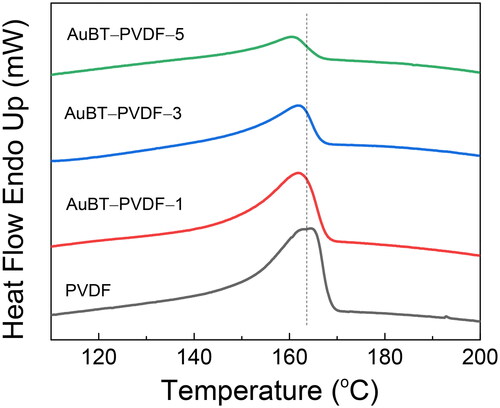 ?Mathematical formulae have been encoded as MathML and are displayed in this HTML version using MathJax in order to improve their display. Uncheck the box to turn MathJax off. This feature requires Javascript. Click on a formula to zoom.
?Mathematical formulae have been encoded as MathML and are displayed in this HTML version using MathJax in order to improve their display. Uncheck the box to turn MathJax off. This feature requires Javascript. Click on a formula to zoom.Abstract
In our investigation of poly(vinylidene fluoride) (PVDF) films embedded with Au-BaTiO3 (AuBT) nanoparticles, we noted a synergistic improvement in both thermal stability and dielectric properties. PVDF films with varying concentrations of AuBT were expertly fabricated. Remarkably, the films retained their flexibility even at a high volume fraction of filler (fAuBT = 0.5). The predominant phases of PVDF (α, β, and γ) were observed. An increase in fAuBT resulted in a modest decrease in the melting temperature, while simultaneously causing a significant 40% increase in thermal conductivity compared to pure PVDF. The dielectric permittivity reached ∼160 at 1 kHz, while maintaining a loss tangent of ∼0.05. These improvements were attributed to discrete Au growth on BT particles, hindering conduction in PVDF. The rise in dielectric response resulted from interfacial polarization and inherent high dielectric permittivity of BT.
1. Introduction
Flexible polymer dielectric nanocomposites have gained significant attention due to their inherent benefits, including light weight, superior flexibility, suitability for polymer-based electronics, ease of low-temperature fabrication, and high breakdown voltage [Citation1–4]. However, the dielectric permittivity (ε′) of polymers is relatively low (ε′<10) [Citation2,Citation3]. To leverage these polymers in dielectric applications like charge storage capacitors, transducers, and other electronic devices [Citation1], their dielectric properties must be enhanced. One effective approach involves integrating the polymer matrix with fillers, aiming to boost its dielectric performance while preserving its intrinsic flexibility.
Enhancing dielectric properties in polymer composites is predominantly influenced by two factors. Firstly, the choice of the polymer matrix, which can be broadly classified into nonpolar and polar categories. Polar polymers, owing to their dipole moments, generally display a higher ε′ compared to nonpolar polymers. Given this context, this study employs poly(vinylidene fluoride) (PVDF) as the matrix. PVDF stands out due to its flexibility, ease of processing, and high breakdown strength [Citation5]. Importantly, PVDF can adopt five distinct phases: α, β, γ, δ, and ε. Among these, the β-phase is notable for its high dipole moment, leading to enhanced polarization and subsequently, superior dielectric behavior [Citation2]. Regrettably, the ε′ of PVDF, at approximately 6–12 [Citation5], remains notably lower than that of dielectric ceramics.
The type and nature of fillers play a crucial role in defining the dielectric properties of polymer nanocomposites. Generally, these fillers can be classified into two main categories based on their electrical properties. The first category encompasses non-conductive ceramic oxide particles, which can exhibit a high ε′. Notable examples are TiO2-nanostructured materials [Citation6], La2−xSrxNiO4 [Citation7], (La, Nb) codoped TiO2 [Citation8], and CaCu3Ti4O12 [Citation9]. Such fillers have the potential to elevate the ε′ of polymer composites. However, incorporating them in large volume fractions (f > 0.5) could present challenges. Specifically, it can lead to an increased tanδ value (>0.1). Excessive filler can also promote agglomeration within the polymer matrix, undermining its breakdown strength [Citation1,Citation2]. Additionally, some ceramic-polymer composites, regardless of their specific ε′ values, exhibit a ε′ value below 100 at 1 kHz, potentially limiting their suitability for certain applications. While a La2-xSrxNiO4-PVDF composite system might exhibit a high ε′ of 103, its tanδ remains significantly elevated.
The second category involves conductive fillers, which include metal nanoparticles [Citation10,Citation11] and carbon nanotubes [Citation12]. These fillers offer a distinctive advantage: they enhance the dielectric response while maintaining the flexibility of a polymer matrix, even at lower filler concentrations (f < 0.5). Li et al. [Citation13] developed multiwalled carbon nanotubes (MWCNT)/PVDF composites with a remarkable ε′ of around 3.7 × 103. However, a drawback arises when the inclusion of these conductive fillers nears the percolation threshold, potentially leading to unintended conductive pathways. This can result in heightened conductivity and an elevated tanδ, both of which are unfavorable for numerous applications. In two-phase systems where spherical particles are randomly dispersed within conductive filler-polymer composites, the percolation threshold is typically around 16 vol% (fc = 0.16) [Citation14]. Unfortunately, as the filler concentration approached fc, where a high ε′ was observed, both tanδ and the conductivity of this composite system significantly increased.
To address the limitations inherent in two-phase polymer composites, researchers have increasingly turned to three-phase polymer composites. These utilize hybrid fillers, a combination of ceramics and metal nanoparticles, renowned for their potential to yield both elevated dielectric values and reduced tanδ values. In such configurations, metal nanoparticles—examples include Ag in formulations like Ag-deposited CaCu3Ti4O12 [Citation15,Citation16] and Ag-deposited BaTiO3 (BT) nanoparticles [Citation17,Citation18]—are meticulously engineered to adhere to the surfaces of ceramic particles. This design ensures that these metal nanoparticles maintain discrete attachment points on the ceramic surfaces, which in turn fosters improved dispersion of ceramic particles within the matrix. Au nanoparticles, in particular, have garnered attention due to their facile linkage to a diverse array of molecules or groups. A variety of these composites, characterized by discontinuous metal nanoparticles decorating ceramic surfaces, have been developed. Notable examples include Au-BT/PVDF [Citation19], Au-Na0.5Y0.5Cu3Ti4O12 [Citation20], Au-deposited TiO2-nanorod [Citation21], and Au-deposited BiFeO3 [Citation22].
Although previous studies have identified bulk composite samples of Au-BT/PVDF and other PVDF matrix composites with Au-based hybrid particles [Citation19–22], the development and detailed analysis of three-phase ceramic-metal particle/PVDF polymer composite films are conspicuously lacking in the scientific literature. Therefore, the primary goal of this study is to design and analyze three-phase AuBT-PVDF polymer nanocomposite films, emphasizing film structures over bulk composite samples, to fill this research gap. Thermal conductivity is crucial in electronic materials, directly affecting their efficacy. Devices generate heat when operational; without proper heat management, performance can deteriorate and lead to potential failures. Thus, analyzing the thermal conductivity of AuBT-PVDF films is vital for both academic insights and ensuring device longevity and safety. Therefore, the novelty of this study lies in fabricating flexible AuBT-PVDF films that demonstrate improved thermal conductivity, a characteristic not previously reported in existing literature.
In this study, we fabricated AuBT-PVDF polymer nanocomposite films, with a targeted focus on attenuating their tanδ and amplifying the ε′ value across a range of temperatures. We delved deeply into the dielectric and thermal attributes of these films, offering a detailed and comprehensive characterization. Ultimately, our results illuminated the potential of this material for integration into dielectric capacitors, possibly marking a significant step forward in the pursuit of optimized capacitor components.
2. Experimental details
2.1. Materials
Gold (III) chloride trihydrate (HAuCl4·3H2O, ≥99.9%), BaTiO3 nanopowder (cubic crystalline phase) with a particle size of <100 nm (≥99%), Poly(vinylidene fluoride) with an average MW of approximately 534,000, sodium citrate tribasic sesquihydrate (C6H5Na3O7·2H2O, ≥99%), and dimethyl sulfoxide (DMSO, (CH3)2SO, ≥99.5%) were purchased from Sigma Aldrich. Dimethylformamide (DMF, HCON(CH3)2, purity: >99%) was acquired from RCI Labscan.
2.2. Preparation of AuBT hybrid particles
The AuBT hybrid particles were synthesized using a modified Turkevich method [Citation23], a technique that employs sodium citrate in deionized water to reduce Au ion precursors. First, 1.4 g of BT particles were suspended in 50 mL of deionized water, followed by stirring for 30 min at ∼25 °C to ensure an even BT dispersion. Subsequently, 500 µL of 0.65 mM HAuCl4·3H2O was introduced into the solution, which was then brought to boiling under continuous stirring. After this, 4 mL of 38.8 mM sodium citrate was added, and the reaction was allowed to proceed until the mixture turned red. The solution was cooled to ambient temperature, and the formed suspension was repeatedly washed with deionized water. The resultant AuBT hybrid particles were then subjected to the freeze-drying technique as described in previous work [Citation24]. A schematic of the synthesis process can be found in Figure S1 (supplementary information).
2.3. Preparation of AuBT-PVDF nanocomposites films
The AuBT-PVDF polymer nanocomposites were synthesized through the following procedure: Initially, a specific quantity of PVDF powder was dispersed in DMF and stirred for 0.5 h. Concurrently, the AuBT powder was dispersed in DMSO and subjected to ultrasonic treatment for 1 h. The resultant solution was further agitated using ultrasonication for 1 h to ensure uniform dispersion of the AuBT nanoparticles, followed by overnight stirring. The mixture was then dried in an oven set at 70 °C. Using this methodology, AuBT-PVDF samples were produced with concentrations denoted by fAuBT values of 0, 0.1, 0.2, 0.3, 0.4, and 0.5. These samples are labeled as PVDF, AuBT-PVDF-1, AuBT-PVDF-2, AuBT-PVDF-3, AuBT-PVDF-4, and AuBT-PVDF-5, respectively. The same preparation procedure is applicable for crafting BT-PVDF polymer nanocomposites. For BT-PVDF samples with fBT values of 0.1, 0.2, 0.3, 0.4, and 0.5, they are designated as BT-PVDF-1, BT-PVDF-2, BT-PVDF-3, BT-PVDF-4, and BT-PVDF-5, respectively.
2.4. Characterization techniques and dielectric measurements
The microscopic structure of AuBT hybrid particles was observed using a transmission electron microscope (TEM, TECNAI G2 20). The morphology of the AuBT-PVDF nanocomposites was investigated using focused ion beam-field emission scanning electron microscopy (FIB-FESEM, FEI Helios NanoLab G3 CX). The phase composition of the AuBT particles was ascertained with an X-ray diffractometer (XRD; PANalytical). Additionally, the surface functionality and crystalline phase of the AuBT-PVDF nanocomposite samples were probed using Fourier transform infrared spectroscopy (FTIR, TENSOR27) in a wavenumber range of 600–1700 cm−1. The thermal behavior was assessed via differential scanning calorimetry (DSC; PerkinElmer, 8000 Advanced Double-Furnace). Dielectric and electrical property measurements were conducted using the KEYSIGHT E4990A Impedance Analyzer, covering a frequency range from 100 Hz to 10 MHz. The temperature-dependent dielectric properties were examined from −60 to 140 °C. The AuBT-PVDF nanocomposites’ thermal conductivities were determined using the LINSEIS LFA 500 Light Flash series (Linseis Messgeraete GmbH, Germany). For this purpose, the polymer composite samples were molded into disks, 12.7 mm in diameter and with thicknesses between 0.5 and 0.7 mm. Tensile test was carried out on a universal testing machine (UTM) (INTSTRON, 5567 A) with stretching rate of 5 mm/min.
3. Results and discussion
The morphology of the filler particles was primarily examined using the TEM technique. As depicted in Figure S2, distinct differences between BT and AuBT hybrid nanoparticles were evident, indicating the successful creation of AuBT hybrid nanoparticles with an average Au particle size of about 12.6 ± 3.0 nm. Based on previous research, we deduced using UV-vis spectroscopy that the Au nanoparticles were attached to the BT surface via a modified Turkevich method [Citation25]. Additionally, we demonstrated that the weight percentage ratio of Au:BT in the AuBT hybrid particles was 0.5:99.5% [Citation25].
and display the FE-SEM images of fractured cross-sections of two-phase BT-PVDF polymer nanocomposite films with fBT values of 0.3 and 0.5. The observed agglomeration of BT can be attributed to the high surface free energy of the BT nanoparticles. Subsequently, the produced AuBT hybrids were integrated with the PVDF polymer matrix at fAuBT values of 0.3 and 0.5 to fabricate AuBT-PVDF polymer nanocomposite films, as seen in and . The AuBT nanoparticles were homogeneously and randomly dispersed within the polymer matrix. The AuBT-PVDF-3 film exhibited fewer pores than the BT-PVDF-3. Additionally, a continuous PVDF polymer matrix phase was noticeable in the AuBT-PVDF-3. The reduced surface free energy of the hybrid particles, achieved by the adhesion of Au nanoparticles to the BT surface, accounts for this observation. A smoother filler particle surface in the BT-PVDF-5 was evident when compared to the two-phase film, (d). This could be due to the PVDF polymer phase enveloping the hybrid particles more uniformly, resulting in a continuous phase across the matrix. The thicknesses of both BT-PVDF and AuBT-PVDF films ranged from 0.12 to 0.5 mm. It is noteworthy that the nanocomposite films retained significant flexibility. They could be twisted and rolled without incurring any damage, as demonstrated in the inset images of . Comprehensive photographic representations of all samples are presented in Figure S3.
Figure 1. FE-SEM cross-sectional images of (a) BT-PVDF-3, (b) BT-PVDF-5 (c) AuBT-PVDF-3, and (d) AuBT-PVDF-5 nanocomposite films.
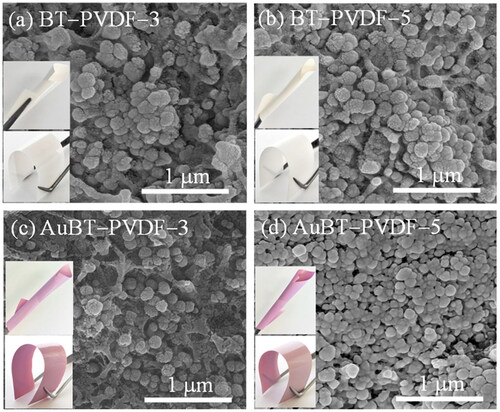
The characterization of phases in PVDF, AuBT powder, and AuBT-PVDF films is crucial for understanding their potential properties and applications. XRD patterns were initially used to elucidate the phases of PVDF and filler materials. As evidenced in Figure S4, only the BT phase is discernible in the AuBT-PVDF films. Interestingly, the XRD peaks associated with PVDF and Au remain elusive in the nanocomposite films. This is likely due to the intrinsically low intensity of the semicrystalline PVDF and the minimal presence of Au. Consequently, discerning phases within the PVDF matrix becomes a challenge. To bridge this gap, FTIR spectroscopy offers a deeper insight. In , the FTIR spectra of the nanocomposite films span a range from 700 to 1500 cm−1. Vibrations observed at 766, 876, 1168, and 1400 cm−1 are indicative of the α-phase. In contrast, the γ-phase is characterized by peaks at 812 and 1233 cm−1 [Citation26–29]. Furthermore, resonances at 840, 1079, 1275, and 1430 cm−1 confirm the presence of the β-phase [Citation26–28,Citation30,Citation31]. The existence of polar phases within these films is pivotal, often leading to enhanced ε′. However, the dielectric properties are usually not solely dictated by these polar phases. The nature of the fillers, especially their distribution within the polymer matrix, plays an equally, if not more, significant role in defining the characteristics of a material.
Figure 2. FTIR spectra of pure PVDF films compared to AuBT-PVDF nanocomposite films with varying AuBT hybrid contents.
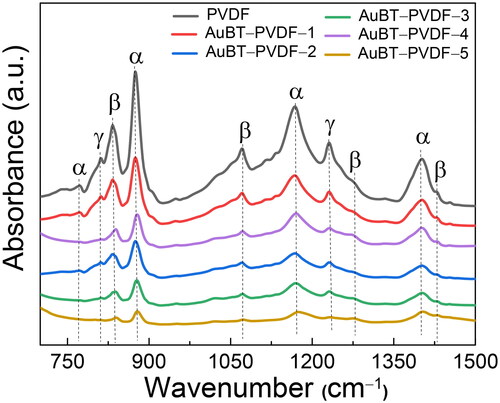
In our prior research [Citation25] it was elucidated through zeta potential measurements that the AuBT hybrid particles possess a negative charge on their surfaces. This results in the alignment of positive dipoles on the opposing side of the polymer matrix, as illustrated in . Acting as nucleating agents, the AuBT hybrid fillers promote the crystallization of the β-phase within the polymer composite films. The conformation of the β-phase, however, can be influenced by several factors. Polar solvents [Citation4,Citation32–34], temperature fluctuations [Citation4], mechanical interventions like stretching, variations in volume fraction, filler incorporation, and filler size [Citation35] can either augment or reduce the β-phase formation. Additionally, blending methods and specific preparation processes of polymer nanocomposites also play crucial roles in determining the phase formation [Citation2,Citation36].
Figure 3. Schematic representation of the β-phase nucleation mechanism through positive ion − CH dipole interactions.
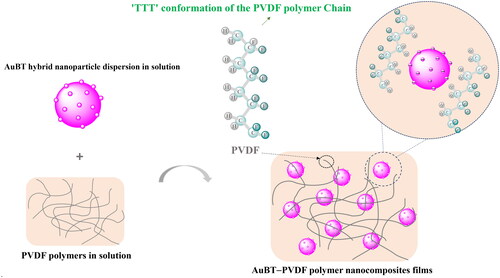
The thermal properties of the nanocomposite films were analyzed using the DSC technique. The degree of crystallinity (Xc) for the polymer nanocomposites was determined using the equation:
(1)
(1)
where Tm represents the melting temperature, while ΔHm signifies the melting enthalpy (enthalpy of fusion). The ΔHm of all nanocomposite films is compared to that for pure PVDF, which is 104.7 J/g [Citation37]. illustrates the DSC results for both pure PVDF and the AuBT-PVDF nanocomposite films. As the concentration of AuBT hybrids increases, there is a discernible shift in Tm peaks toward slightly lower temperatures. This suggests that the AuBT hybrids have a noticeable impact on the degree of crystallinity and ΔHm in the polymer nanocomposites. These finding values are collated in . For PVDF, the initial Xc value was 34.74%, which dropped to 11.73% in the AuBT-PVDF films with fAuBT = 0.5. This reduction indicates that AuBT hybrids may hinder crystallization, possibly due to PVDF polymer chain blockages from defects.
Table 1. Melting temperature, melting enthalpy, and crystallinity degree of AuBT-PVDF composites films with various contents increased AuBT hybrids.
The thermal diffusivity (α) of all samples was measured using the laser flash techniques. The thermal conductivity (κ) was derived using the equation:
(2)
(2)
where
denotes the specific heat capacity, determined via DSC techniques. Meanwhile, ρ is the density. illustrates both α and κ values for the pure and nanocomposite films. For pure PVDF, AuBT-PVDF-3, and AuBT-PVDF-5, the α values were recorded as 0.131, 0.195, and 0.256 mm2/s, respectively. In comparison, the κ values were 0.166, 0.238, and 0.237 W/mK, respectively. Bonno et al. [Citation38] reported a κ of 0.16 W/mK for PVDF film. The κ of nanocomposite films showed a significant increase with rising fAuBT. Typically used fillers in nanocomposites fall into categories such as carbonaceous, ceramic, and metallic fillers [Citation39,Citation40]. These fillers can amplify the κ of polymer nanocomposites. Incorporating metallic fillers can also raise the electrical conductivity, which may not be desirable for certain applications.
Figure 5. Thermal diffusivity and thermal conductivity of AuBT-PVDF nanocomposites and pure PVDF film.
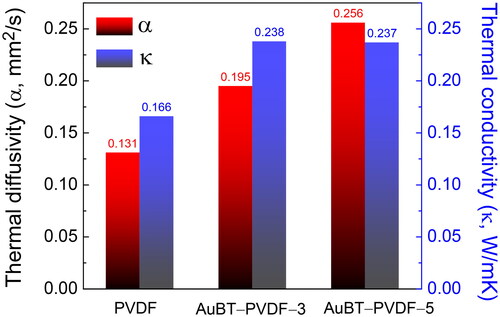
The ε′ and tanδ at 25 °C for AuBT-PVDF nanocomposite films with different fAuBT levels are illustrated in . As fAuBT increases, ε′ shows a corresponding rise over the measured frequency range, while being only slightly influenced by frequency as seen in (a). The summarized values for ε′ and tanδ can be found in . For all volume fractions, the ε′ for AuBT-PVDF films exceeded that of BT-PVDF films, while tanδ was substantially reduced, by approximately an order of magnitude. This significant enhancement in ε′ for the AuBT-PVDF films can be attributed to the effect of the Au nanoparticles deposited on the BT surface. This deposition amplifies the interfacial polarization between the conductive (Au) phase and insulating phases (PVDF and BT). Conversely, the agglomeration of BT nanoparticles in the BT-PVDF films resulted in an uptick in tanδ due to the leakage current from surface charges on the BT nanoparticles [Citation41].
Figure 6. Frequency dependence at ∼25 °C of (a) ε′ and (b) tanδ for AuBT-PVDF polymer nanocomposites with various contents of AuBT hybrids fillers.

Table 2. Dielectric parameters (ε′ and tanδ at 1 kHz and 25 °C) and mechanical properties (toughness (σT) and young’s modulus (Y)) of BT-PVDF and AuBT-PVDF nanocomposite films with various volume fractions.
The highest ε′ value of 160.2 with a low tanδ (∼0.052) was achieved in the AuBT-PVDF-5. The dielectric parameters (ε′ and tanδ at 1 kHz and ∼25 °C) are compared with those reported in the literature for three-phase composites, as presented in . Clearly, the AuBT-PVDF composite films exhibited superior dielectric properties compared to those of bulk polymer composites. This behavior might be explained by the one-dimensional confinement structure of the nanoparticles. Such confinement forces the electrons in nanomaterials to move within a limited volume, thus creating differential absorbance values between Au nanoparticles and microparticles. The underlying phenomenon, known as surface plasmon resonance, results from oscillations of free electrons and the charge density wave they induce. Given their high surface-to-volume ratio, Au nanoparticles are more reactive, as a higher proportion of atoms are exposed on their surfaces. This smaller size constrains the wave functions of valent electrons, altering the electrical properties and leading to potential metal-insulator transitions. Such nanoparticles might exhibit discrete electronic conditions, with specifically quantized values, thus introducing unique properties and phenomena like quantum confinement effects and the Coulomb blockade [Citation42,Citation43]. Furthermore, the decoration of BT surfaces with Au nanoparticles aids in the dispersion of BT within the polymer matrix during film casting. A homogenous dispersion of filler nanoparticles within a polymer matrix often results in a superior dielectric response compared to inhomogeneous mixtures [Citation44]. This factor also contributes to the heightened dielectric response in AuBT-PVDF nanocomposites. As seen in (b), tanδ values at higher frequencies—stemming from the C − F dipole orientation polarization of the PVDF matrix—diminished as fAuBT grew, reflecting the reduced volume fraction of the PVDF phase [Citation44,Citation45]. In the frequency range of 102–104 Hz, tanδ remained relatively stable. Large tanδ values at lower frequencies typically indicate extended motion of free charges. This behavior suggests that DC conduction, linked to the formation of a conductive pathway within the polymer matrix, is suppressed due to the discrete growth of Au nanoparticles on the BT surface. Consequently, further investigation into the conductivity of AuBT-PVDF films is warranted.
Table 3. ε′ And tanδ at 1 kHz and ∼25 °C of bulk three-phase composites with filler volume fraction of 0.4–0.6.
For applications in modern smart microelectronics, not only the enhanced dielectric properties are crucial, but also the flexibility and mechanical strength of dielectric composite materials. The stress–strain curves of the pure PVDF polymer and AuBT-PVDF films with fAuBT values of 0.4 and 0.5 were evaluated due to their large ε′ values (>100). As presented in , the modulus (Y) of the PVDF polymer can be increased by incorporating 40 vol.% AuBT, but it then decreased when the AuBT content was increased to 50 vol.%. By analyzing the area under the stress–strain curves, it is evident that the toughness (σT) of the AuBT-PVDF films diminished as fAuBT increased. However, as indicated in the insets of , the AuBT-PVDF films with an fAuBT of 0.5 maintain their flexibility.
The conductivity (σAC) at ∼25 °C for the AuBT-PVDF films is represented in . At low frequencies, the σAC—essentially representing DC conductivity (σDC)—exhibits a modest uptick with an increase in fAuBT. Notably, even at fAuBT = 0.5, the DC conductivity remains largely stable, underscoring the absence of any rapid alterations. This stability unambiguously indicates the lack of a percolation network within the polymer nanocomposites. Additionally, the σAC of the AuBT-PVDF-5 nanocomposites remains inferior to other composite systems, such as those with OPA-modified Ag@TiO2 nanoparticles, which have a conductivity of approximately 3 × 10−6 Scm−1 [Citation50].
Figure 7. AC conductivity (σAC) of AuBT-PVDF polymer nanocomposites with various fAuBT at room temperature.
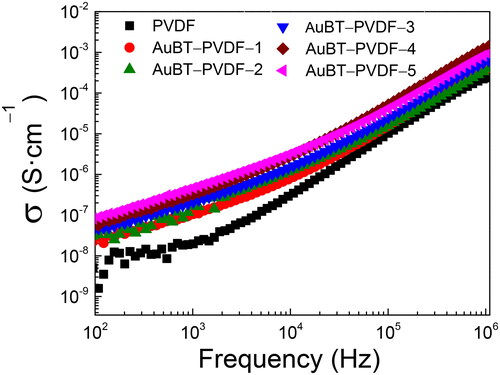
illustrates the impact of temperature on the ε′ and tanδ values for the AuBT-PVDF nanocomposite films. As temperature rises, there is a notable increase in ε′. This can likely be attributed to increased dipole motion in the elevated temperature regions. On the other hand, at diminished temperatures, dipoles might become dormant, or ‘frozen’, rendering them motionless. Moreover, tanδ reveals two distinct relaxation peaks characteristic of the PVDF polymer: the β-relaxation occurring between approximately −60 and 0 °C, and the α-relaxation manifesting at temperatures exceeding 50 °C [Citation51]. In the higher temperature spectrum, tanδ for AuBT-PVDF-5 is observed to be the lowest, suggesting a minimized effect of DC conduction. Such observations lend weight to the hypothesis that the inception of a conductive pathway might be deterred, especially given that tanδ in this temperature range is largely governed by DC conduction.
Figure 8. Temperature dependence at 1 kHz of (a) ε′ and (b) tanδ for AuBT-PVDF nanocomposite films with various contents of AuBT fillers.

To characterize the dependence of the ε′ of the AuBT-PVDF films on the fAuBT fraction, the experimental data were analyzed using various theoretical models. These included the logarithmic (LG) [Citation52–55], Maxwell − Garnett (MG) [Citation52–54,Citation56], and effective medium theory (EMT) models [Citation52–55]. Each model was applied in accordance with EquationEquations (3)–(5), respectively.
(3)
(3)
(4)
(4)
(5)
(5)
where ε′ represents the effective dielectric permittivity of the AuBT-PVDF films. εPVDF is the dielectric constant of the PVDF polymer (approximately 11) and εAuBT denotes the dielectric constant of AuBT (2000). The term n refers to the filler morphology fitting factor. A smaller value of n obtained from fitting suggests that the shape of filler is closer to spherical [Citation55].
As depicted in , the ε′ values predicted by both the LG and MG models significantly deviated from the experimentally observed ε′ values. Remarkably, the EMT model successfully fitted the experimental ε′ values of the AuBT-PVDF films, yielding an n value of 0.065. This n value from the EMT model is lower than those found in the Na0.5Bi0.5Cu3Ti4O12/PVDF [n = 0.13] [Citation53] and CaCu3Ti4O12/PVDF [n = 0.11] composite systems [Citation52]. However, it is closely aligned with the n value of KTa0.5Nb0.5O3/PVDF nanocomposite films [n = 0.075], which utilized nano-cubes of KTa0.5Nb0.5O3 as filler [Citation54]. It was also observed that the n value for the KTa0.5Nb0.5O3/PVDF system increased from 0.075 to 0.088 with an increase in the size of the KTa0.5Nb0.5O3 nano-cubes. The relatively smaller n value in the AuBT-PVDF films is attributed to the spherical shape of BT, as illustrated in Figure S2. A slight discrepancy between the experimental and theoretical ε′ values arises since the EMT model does not account for the interface effect between the PVDF matrix and the AuBT hybrid particles. It is noteworthy that the rapid change in ε′ observed in is not associated with a percolation effect, thus indicating an enhanced dielectric response in the AuBT-PVDF films unrelated to this phenomenon.
Figure 9. Variation of ε′ at 1 kHz and ∼25 °C for AuBT-PVDF nanocomposite films with fAuBT = 0–0.5 compared to theoretical models in EquationEquations (3)–(5).
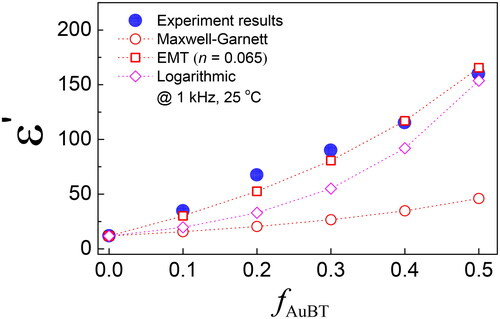
4. Conclusions
This study introduces an innovative method to enhance the dielectric properties of PVDF nanocomposite films with AuBT hybrid nanoparticles. Using solution casting, we crafted the AuBT-PVDF films. Our research underscores their notable characteristics, especially when modifying the fAuBT levels. Remarkably, the films maintained flexibility even with a high filler loading of fAuBT = 0.5. We observed alterations in PVDF phases and a slight drop in melting temperature with increased fAuBT. Notably, at fAuBT = 0.5, thermal conductivity rose significantly, emphasizing the heat transfer potential of AuBT nanoparticles. The nanocomposites showcased superior dielectric behavior, with an impressive ε′ value of ∼160 and stable performance across a wide temperature span. The consistently low tanδ values, even at heightened temperatures, can be attributed to the Au nanoparticles on the BT surface. The ε′ as a function of fAuBT was accurately modeled using the EMT model. Incorporating AuBT nanoparticles into PVDF films presents a potent approach to boost their dielectric traits, suggesting broader applications in industries requiring advanced dielectric materials.
-)Supplementary Information.doc
Download MS Word (18.6 MB)Disclosure statement
No potential conflict of interest was reported by the author(s).
Additional information
Funding
Notes on contributors
Kaniknun Sreejivungsa
Dr. Kaniknun Sreejivungsa received her Ph.D. degree (in Physics) at Khon Kaen University (KKU) in 2022. She is now a postdoctoral fellow at KKU. Her research interests are focused on giant (or colossal) dielectric materials and dielectric polymer composites, as well as giant dielectric-based materials for humidity sensors.
Pornsawan Kum-onsa
Dr. Pornsawan Kum-onsa received her Ph.D. degree (in Materials Science and Nanotechnology Program) at Khon Kaen University in 2020. She joined Burapha University in 2021. Her research interests are focused on giant (or colossal) dielectric materials and dielectric polymer composites.
Prasit Thongbai
Prof. Dr. Prasit Thongbai received his Ph.D. degree (in Physics) at Khon Kaen University (KKU) in 2010. He joined KKU in 2010, and now he is a Prof. in Materials Science in KKU. His research interests are focused on giant (or colossal) dielectric materials and dielectric polymer composites, as well as giant dielectric-based materials for varistors and humidity sensors.
References
- Dang Z-M, Yuan J-K, Zha J-W, et al. Fundamentals, processes and applications of high-permittivity polymer–matrix composites. Prog Mater Sci. 2012;57(4):660–723. doi: 10.1016/j.pmatsci.2011.08.001.
- Martins P, Lopes AC, Lanceros-Mendez S. Electroactive phases of poly(vinylidene fluoride): determination, processing and applications. Prog Polym Sci. 2014;39(4):683–706. doi: 10.1016/j.progpolymsci.2013.07.006.
- Prateek, Thakur VK, Gupta RK. Recent progress on ferroelectric polymer-Based nanocomposites for high energy density capacitors: synthesis, dielectric properties, and future aspects. Chem Rev. 2016;116(7):4260–4317. doi: 10.1021/acs.chemrev.5b00495.
- Ting Y, Suprapto, Chiu C-W. Characteristic analysis of biaxially stretched PVDF thin films. J Appl Polym Sci. 2018;135(36):46677.
- Tan Q, Irwin P, Cao Y. Advanced dielectrics for capacitors. IEEJ Trans Fundam Mater. 2006;126(11):1153–1159. doi: 10.1541/ieejfms.126.1153.
- Kum-Onsa P, Chanlek N, Thongbai P. Largely enhanced dielectric properties of TiO2-nanorods/poly(vinylidene fluoride) nanocomposites driven by enhanced interfacial areas. Nanocomposites. 2021;7(1):123–131. doi: 10.1080/20550324.2021.1952371.
- Meeporn K, Thongbai P. Flexible La1.5Sr0.5NiO4/poly(vinylidene fluoride) composites with an ultra high dielectric constant: a comparative study. Compos Part B Eng. 2020;184:107738. doi: 10.1016/j.compositesb.2019.107738.
- Zeng Y, Xiong C, Li J, et al. Structural, dielectric and mechanical behaviors of (La, Nb) co-doped TiO2/silicone rubber composites. Ceram Int. 2021;47(16):22365–22372. doi: 10.1016/j.ceramint.2021.04.245.
- Kaur S, Singh DP. On the structural, dielectric and energy storage behaviour of PVDF- CaCu3Ti4O12 nanocomposite films. Mater Chem Phys. 2020;239:122301. doi: 10.1016/j.matchemphys.2019.122301.
- Huang X, Jiang P, Xie L. Ferroelectric polymer/silver nanocomposites with high dielectric constant and high thermal conductivity. Appl Phys Lett. 2009;95(24):242901.
- Phromviyo N, Chanlek N, Thongbai P, et al. Enhanced dielectric permittivity with retaining low loss in poly(vinylidene fluoride) by incorporating with Ag nanoparticles synthesized via hydrothermal method. Appl Surf Sci. 2018;446:59–65. doi: 10.1016/j.apsusc.2018.02.188.
- Liu L, Matitsine S, Gan YB, et al. Frequency dependence of effective permittivity of carbon nanotube composites. J Appl Phys. 2007;101(9):094106.
- Li Q, Xue Q, Zheng Q, et al. Large dielectric constant of the chemically purified carbon nanotube/polymer composites. Mater Lett. 2008;62(26):4229–4231. doi: 10.1016/j.matlet.2008.06.047.
- Nan CW, Shen Y, Ma J. Physical properties of composites near percolation. Annu Rev Mater Res. 2010;40(1):131–151. doi: 10.1146/annurev-matsci-070909-104529.
- Ghosh B, Tamayo Calderón RM, Espinoza-González R, et al. Enhanced dielectric properties of PVDF/CaCu3Ti4O12: ag composite films. Mater Chem Phys. 2017;196:302–309. doi: 10.1016/j.matchemphys.2017.05.009.
- Yang Y, Sun H, Yin D, et al. High performance of polyimide/CaCu3Ti4O12@Ag hybrid films with enhanced dielectric permittivity and low dielectric loss. J Mater Chem A. 2015;3(9):4916–4921. doi: 10.1039/C4TA05673F.
- Luo S, Yu S, Sun R, et al. Nano Ag-Deposited BaTiO3 hybrid particles as fillers for polymeric dielectric composites: toward high dielectric constant and suppressed loss. ACS Appl Mater Interfaces. 2014;6(1):176–182. doi: 10.1021/am404556c.
- Silakaew K, Chanlek N, Manyam J, et al. Highly enhanced frequency- and temperature-stability permittivity of three-phase poly(vinylidene-fluoride) nanocomposites with retaining low loss tangent and high permittivity. Results Phys. 2021;26:104410. doi: 10.1016/j.rinp.2021.104410.
- Singh D, Singh N, Garg A, et al. Engineered thiol anchored Au-BaTiO3/PVDF polymer nanocomposite as efficient dielectric for electronic applications. Compos Sci Technol. 2019;174:158–168. doi: 10.1016/j.compscitech.2019.02.015.
- Kum-Onsa P, Phromviyo N, Thongbai P. Suppressing loss tangent with significantly enhanced dielectric permittivity of poly(vinylidene fluoride) by filling with Au–Na1/2Y1/2Cu3Ti4O12 hybrid particles. RSC Adv. 2020;10(66):40442–40449. doi: 10.1039/d0ra06980a.
- Kum-Onsa P, Chanlek N, Manyam J, et al. Gold-Nanoparticle-Deposited TiO2 nanorod/poly(vinylidene fluoride) composites with enhanced dielectric performance. Polymers. 2021;13(13):2064. doi: 10.3390/polym13132064.
- Kum-Onsa P, Chanlek N, Putasaeng B, et al. Improvement in dielectric properties of poly(vinylidene fluoride) by incorporation of Au–BiFeO3 hybrid nanoparticles. Ceram Int. 2020;46(11):17272–17279. doi: 10.1016/j.ceramint.2020.04.014.
- Turkevich J, Stevenson PC, Hillier J. A study of the nucleation and growth processes in the synthesis of colloidal gold. Discuss Faraday Soc. 1951;11(0):55–75. doi: 10.1039/df9511100055.
- Phromviyo N, Thongbai P, Maensiri S. High dielectric permittivity and suppressed loss tangent in PVDF polymer nanocomposites using gold nanoparticle–deposited BaTiO3 hybrid particles as fillers. Appl Surf Sci. 2018;446:236–242. doi: 10.1016/j.apsusc.2018.01.045.
- Sreejivungsa K, Phromviyo N, Swatsitang E, et al. Characterizations and significantly enhanced dielectric properties of PVDF polymer nanocomposites by incorporating gold nanoparticles deposited on BaTiO3 nanoparticles. Polymers. 2021;13(23):4144. doi: 10.3390/polym13234144.
- Cai X, Lei T, Sun D, et al. A critical analysis of the α, β and γ phases in poly(vinylidene fluoride) using FTIR. RSC Adv. 2017;7(25):15382–15389. doi: 10.1039/C7RA01267E.
- Ruan L, Yao X, Chang Y, et al. Properties and applications of the β phase poly(vinylidene fluoride). Polymers. 2018;10(3):228. doi: 10.3390/polym10030228.
- Choi MH, Yang SC. CoFe2O4 nanofiller effect on β-phase formation of PVDF matrix for polymer-based magnetoelectric composites. Mater Lett. 2018;223:73–77. doi: 10.1016/j.matlet.2018.04.024.
- Mandal D, Henkel K, Schmeißer D. The electroactive β-phase formation in poly(vinylidene fluoride) by gold nanoparticles doping. Mater Lett. 2012;73:123–125. doi: 10.1016/j.matlet.2011.11.117.
- Low YKA, Tan LY, Tan LP, et al. Increasing solvent polarity and addition of salts promote β-phase poly(vinylidene fluoride) formation. J Appl Polym Sci. 2013;128(5):2902–2910. doi: 10.1002/app.38451.
- Biswas A, Henkel K, Schmeißer D, et al. Comparison of the thermal stability of the α, β and γ phases in poly(vinylidene fluoride) based on in situ thermal Fourier transform infrared spectroscopy. Phase Transit. 2017;90(12):1–9. doi: 10.1080/01411594.2017.1337902.
- Zhao Y, Zhou Y, Yang Y, et al. The impact of solvents on properties of solution-cast poly(vinylidene fluoride) films for energy storage. Mater Lett. 2018;219:201–204. doi: 10.1016/j.matlet.2018.02.110.
- Li X, Wang Y, He T, et al. Preparation of PVDF flexible piezoelectric film with high β-phase content by matching solvent dipole moment and crystallization temperature. J Mater Sci Mater Electron. 2019;30(22):20174–20180.
- Tao M-M, Liu F, Ma B-R, et al. Effect of solvent power on PVDF membrane polymorphism during phase inversion. Desalination. 2013;316:137–145. doi: 10.1016/j.desal.2013.02.005.
- Mendes SF, Costa CM, Caparros C, et al. Effect of filler size and concentration on the structure and properties of poly(vinylidene fluoride)/BaTiO3 nanocomposites. J Mater Sci. 2012;47(3):1378–1388. doi: 10.1007/s10853-011-5916-7.
- Correia DM, Costa CM, Lizundia E, et al. Influence of cation and anion type on the formation of the electroactive β-phase and thermal and dynamic mechanical properties of poly(vinylidene fluoride)/ionic liquids blends. J Phys Chem C. 2019;123(45):27917–27926. doi: 10.1021/acs.jpcc.9b07986.
- Muduli SP, Parida S, Rout SK, et al. Effect of hot press temperature on β-phase, dielectric and ferroelectric properties of solvent casted poly(vinyledene fluoride) films. Mater Res Exp. 2019;6(9):095306. doi: 10.1088/2053-1591/ab2d85.
- Bonno B, Laporte JL, d‘León RT. Determination of thermal parameters of PVDF using a photoacoustic technique. Meas Sci Technol. 2001;12(6):671–675. doi: 10.1088/0957-0233/12/6/303.
- Huang C, Qian X, Yang R. Thermal conductivity of polymers and polymer nanocomposites. Mater Sci Eng R Rep. 2018;132:1–22. doi: 10.1016/j.mser.2018.06.002.
- Ebadi-Dehaghani H, Nazempour M. Thermal conductivity of nanoparticles filled polymers. Smart Nanoparticles Technol. 2012;23:519–540.
- Silakaew K, Saijingwong W, Meeporn K, et al. Effects of processing methods on dielectric properties of BaTiO3/poly(vinylidene fluoride) nanocomposites. Microelectron Eng. 2015;146(Supplement C):1–5. doi: 10.1016/j.mee.2015.01.029.
- Xie L, Huang X, Li B-W, et al. Core–satellite Ag@BaTiO3 nanoassemblies for fabrication of polymer nanocomposites with high discharged energy density, high breakdown strength and low dielectric loss. Phys Chem Chem Phys. 2013;15(40):17560–17569. doi: 10.1039/c3cp52799a.
- Wang M, Pan X-R, Qi X-D, et al. Fabrication of Ag@BaTiO3 hybrid nanofibers via coaxial electrospinning toward polymeric composites with highly enhanced dielectric performances. Compos Commun. 2020;21:100411. doi: 10.1016/j.coco.2020.100411.
- Wang Z, Fang M, Li H, et al. Enhanced dielectric properties in poly(vinylidene fluoride) composites by nanosized Ba(Fe0.5Nb0.5)O3 powders. Compos Sci Technol. 2015;117:410–416. doi: 10.1016/j.compscitech.2015.07.018.
- Hu G, Gao F, Kong J, et al. Preparation and dielectric properties of poly(vinylidene fluoride)/Ba0.6Sr0.4TiO3 composites. J Alloys Compd. 2015;619:686–692. doi: 10.1016/j.jallcom.2014.09.005.
- Fang F, Yang W, Yu S, et al. Mechanism of high dielectric performance of polymer composites induced by BaTiO3-supporting Ag hybrid fillers. Appl Phys Lett. 2014;104(13):132909.
- Silakaew K, Thongbai P. Suppressed loss tangent and conductivity in high-permittivity Ag-BaTiO3/PVDF nanocomposites by blocking with BaTiO3 nanoparticles. Appl Surf Sci. 2019;492:683–689. doi: 10.1016/j.apsusc.2019.06.262.
- Su Y, Gu Y, Li H, et al. Ag-NBCTO-PVDF composites with enhanced dielectric properties. Mater Lett. 2016;185(Supplement C):208–210. doi: 10.1016/j.matlet.2016.08.136.
- Tuichai W, Kum-Onsa P, Danwittayakul S, et al. Significantly enhanced dielectric properties of Ag-deposited (In1/2Nb1/2)0.1Ti0.9O2/PVDF polymer composites. Polymers. 2021;13(11):1788. doi: 10.3390/polym13111788.
- Chen X, Liang F, Lu W, et al. Improved dielectric properties of Ag@TiO2/PVDF nanocomposites induced by interfacial polarization and modifiers with different carbon chain lengths. Appl Phys Lett. 2018;112(16):162902.
- Lopes AC, Costa CM, Serra R, et al. Dielectric relaxation, ac conductivity and electric modulus in poly(vinylidene fluoride)/NaY zeolite composites. Solid State Ionics. 2013;235:42–50. doi: 10.1016/j.ssi.2013.01.013.
- Thomas P, Varughese KT, Dwarakanath K, et al. Dielectric properties of poly(vinylidene fluoride)/CaCu3Ti4O12 composites. Compos Sci Technol. 2010;70(3):539–545. doi: 10.1016/j.compscitech.2009.12.014.
- Su Y-L, Sun C, Zhang W-Q, et al. Fabrication and dielectric properties of Na0.5Bi0.5Cu3Ti4O12/poly(vinylidene fluoride) composites. J Mater Sci. 2013;48(23):8147–8152. doi: 10.1007/s10853-013-7627-8.
- Chen G, Wang X, Lin J, et al. Interfacial polarity modulation of KTa0.5Nb0.5O3 nanoparticles and its effect on dielectric loss and breakdown strength of poly(vinylidene fluoride) nanocomposites with high permittivity. J Phys Chem C. 2016;120(50):28423–28431. doi: 10.1021/acs.jpcc.6b09041.
- Meeporn K, Thongbai P, Yamwong T, et al. Greatly enhanced dielectric permittivity in La1.7Sr0.3NiO4/poly(vinylidene fluoride) nanocomposites that retained a low loss tangent. RSC Adv. 2017;7(28):17128–17136. doi: 10.1039/C7RA01675A.
- Dang Z-M, Shen Y, Nan C-W. Dielectric behavior of three-phase percolative Ni–BaTiO3/polyvinylidene fluoride composites. Appl Phys Lett. 2002;81(25):4814–4816. doi: 10.1063/1.1529085.


